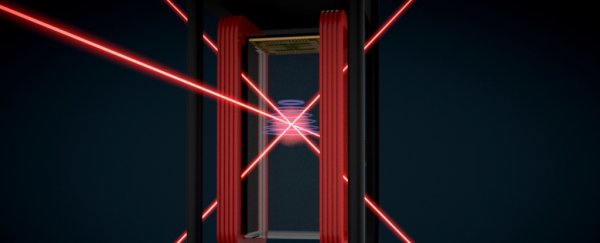In the quest for ever-colder temperatures, NASA is sending an apparatus to the International Space Station that will create a spot 100 million times colder than the vacuum of space.
It's called the Cold Atom Laboratory, a payload about the size of an ice chest aboard Orbital ATK's Cygnus rocket, and it will help scientists observe the weird quantum properties of ultra-cold atoms.
A combination of lasers and magnets will be used to chill and slow a cloud of atoms to just a fraction above absolute zero, also known as zero Kelvin (-273.15 Celsius or -459.67 Fahrenheit).
Absolute zero is the coldest temperature in the Universe - and impossible to achieve, because at that point, atoms stop moving.
But the Cold Atom Laboratory (CAL) can cool clouds of atoms to just one ten millionth of a degree above absolute zero, which causes them to move extremely slowly, exhibiting microscopic quantum phenomena.
These clouds are called Bose-Einstein condensates. They can be created on Earth, but there's a catch - gravity. It acts on the atoms very quickly, reducing their free-fall time, so they can only be observed for a fraction of a second.
The microgravity environment aboard the ISS will overcome this significant problem, allowing scientists on Earth operating the equipment remotely to observe the atoms for up to 10 seconds.
This will be the longest we've ever been able to observe Bose-Einstein condensates, by a wide margin.
This has several scientific benefits. Because Bose-Einstein condensates are what is known as a superfluid - a type of fluid with zero viscosity - it will help us understand them better.
"If you had superfluid water and spun it around in a glass, it would spin forever," CAL project manager Anita Sengupta of JPL said last year.
"There's no viscosity to slow it down and dissipate the kinetic energy. If we can better understand the physics of superfluids, we can possibly learn to use those for more efficient transfer of energy."
It could also help advance superconductivity, and devices such as superconducting quantum interference devices, quantum computers, and laser-cooled atomic clocks. It could allow for the observation of never-before-seen quantum phenomena.
And it could even help detect and understand dark energy, the unknown force accelerating the expansion of the Universe.
"Studying these hyper-cold atoms could reshape our understanding of matter and the fundamental nature of gravity," said CAL project scientist Robert Thompson of JPL.
"The experiments we'll do with the Cold Atom Lab will give us insight into gravity and dark energy - some of the most pervasive forces in the universe."
The Cold Atom Laboratory isn't the only science payload departing for the ISS on Cygnus.
The rocket will also be carrying a handheld sextant to test for emergency star navigation (not to be confused with SEXTANT, the ground-breaking technology that uses pulsars as guide stars); and biomolecule sequencing technology, for sequencing microbes found aboard the ISS.
The launch is scheduled for Monday, May 21 at 08:39 UTC.
